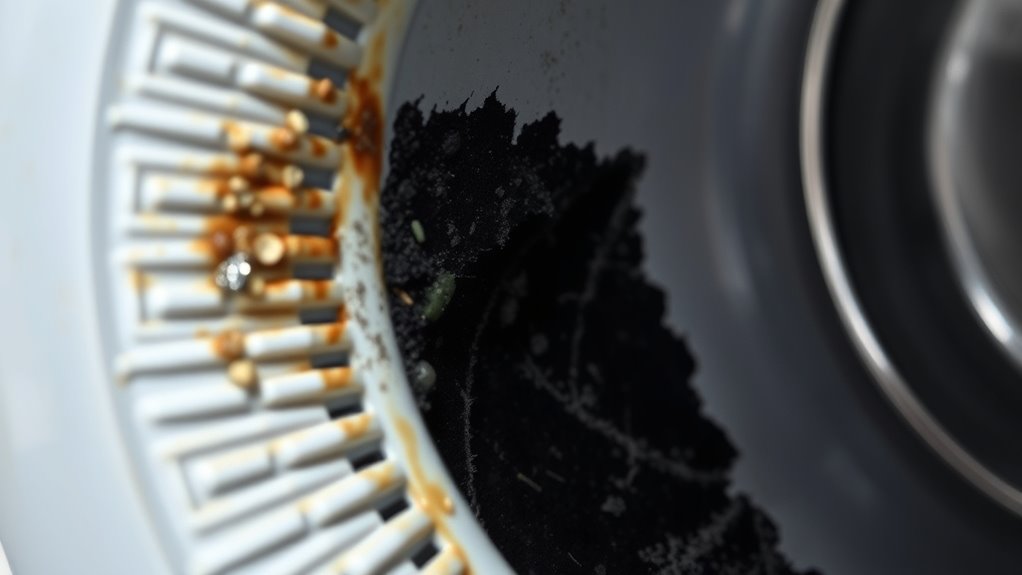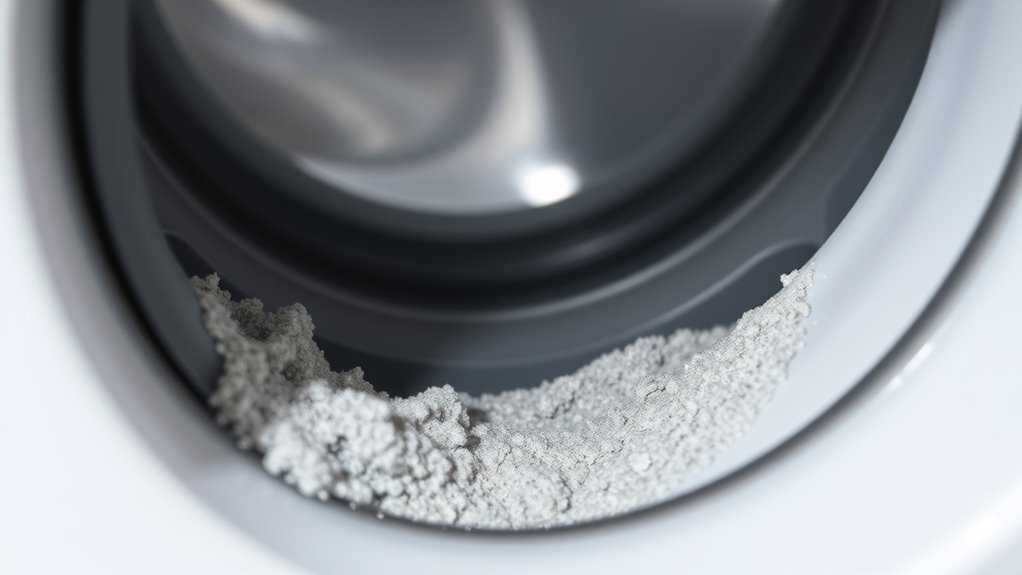To clean mold from your washing machine gasket groove, start by inspecting the area for visible mold or musty smells. Wipe the groove with a damp cloth or soft brush dipped in a mixture of water and white vinegar or mild soap to remove dirt, soap scum, and residue. Be sure to dry the gasket thoroughly afterward, leaving the door open to promote airflow. Regular cleaning and maintenance help prevent future mold growth—stay tuned to protect your washer’s lifespan and hygiene.
Key Takeaways
- Inspect the gasket groove regularly for mold, visible spots, or musty odors.
- Clean the groove with a soft brush and a mixture of water and vinegar or mild soap.
- Dry the gasket thoroughly after cleaning and leave the door open to promote airflow.
- Run an empty hot water cycle with vinegar or washer cleaner to remove residue and prevent mold.
- Maintain routine cleaning and inspection to keep the gasket dry, clean, and mold-free.

If you notice a musty smell or visible black spots in your washing machine, mold could be the culprit. One common area where mold tends to hide is the gasket groove—those folds and crevices around the door seal. Over time, detergent residue and dirt can accumulate in these tight spaces, creating the perfect environment for mold to thrive. It’s essential to clean this area regularly to prevent mold buildup and keep your washer fresh and hygienic.
Mold can hide in the gasket groove, so regular cleaning is essential for a fresh, hygienic washer.
To start, you’ll want to carefully inspect the gasket groove for any visible mold, dirt, or soap scum. Use a damp cloth or soft brush to gently scrub away any grime. Be thorough—mold loves to cling to residue left behind by your detergent or fabric softeners. These residues not only stain the surface but also trap moisture, which can lead to mold growth. When cleaning, consider using a mixture of equal parts water and white vinegar or a mild soap solution. Vinegar is a natural mold inhibitor and helps break down soap scum, making it easier to remove stubborn deposits.
As you clean, pay close attention to the folds and crevices of the gasket. Mold prevention hinges on removing any standing moisture, so after scrubbing, dry the gasket thoroughly with a clean towel. Leaving the door open after each laundry cycle allows air to circulate, reducing humidity inside the drum and gasket area. This simple step makes a significant difference in preventing mold from taking hold.
It’s also important to routinely run an empty hot water cycle with a cup of white vinegar or a washing machine cleaner designed to eliminate mold and residue. This helps flush out any lingering detergent residue that could feed mold growth. Remember, the key to mold prevention is consistency—making cleaning the gasket groove part of your regular laundry routine keeps mold at bay and extends the lifespan of your washing machine.
Don’t forget to check the door seal periodically, especially if you notice a musty smell. Moisture trapped in the gasket groove, coupled with detergent residue, creates an inviting environment for mold. By maintaining a clean, dry gasket and practicing good hygiene habits, you can prevent mold from forming and keep your washing machine smelling fresh. Regular cleaning, proper drying, and using the right cleaning solutions are your best defenses against mold growth in this often-overlooked area. Additionally, understanding the role of moisture in mold development can help you better prevent future growth.
Frequently Asked Questions
How Often Should I Clean the Gasket Groove?
You should clean the gasket groove at least once a month for thorough cleaning frequency and mold prevention. Regular cleaning prevents mold buildup and keeps your washing machine fresh and functioning efficiently. After each wash, wipe the gasket area dry to reduce moisture. By maintaining this routine, you’ll avoid mold growth and guarantee your machine stays clean and odor-free, saving you time and costly repairs down the line.
Can Mold Damage My Washing Machine’s Performance?
Mold is like a sneaky saboteur that can sabotage your washing machine’s performance. It can cause detergent buildup, clogging drains and making your machine less efficient. Over time, mold damages seals and parts, leading to leaks or breakdowns. To keep your washer running smoothly, clean the gasket groove regularly, preventing mold from taking hold and ensuring your machine stays fresh and effective.
Are There Specific Cleaning Products Recommended?
You should use gentle cleaning solutions or mold removers designed for washing machines. Avoid harsh chemicals that might damage the gasket or leave residues. Look for products labeled safe for appliance use, and always follow the instructions on the label. For a natural option, white vinegar or baking soda mixed with water can be effective. Regular cleaning with these solutions helps prevent mold buildup and keeps your washing machine fresh.
How Can I Prevent Mold From Returning?
To prevent mold from returning, guarantee your washing machine has proper ventilation by leaving the door open after each use to let it dry completely. Use mold-resistant sprays on the gasket and gasket groove regularly, and incorporate ventilation tips like checking the drain filter and ensuring your laundry area is well-ventilated. These steps help keep moisture levels low, reducing mold growth and keeping your washer fresh.
Is It Safe to Use Bleach on the Gasket?
Yes, it’s safe to use bleach on the gasket if you dilute it properly, but you need to be cautious about bleach safety and avoid overuse. Use a small amount, and rinse thoroughly to prevent gasket damage. Regularly cleaning with bleach can help eliminate mold without harming your machine, but always follow manufacturer instructions. Avoid harsh scrubbing to prevent damaging the gasket’s material.
Conclusion
To keep your washing machine running smoothly and avoid any unwelcome surprises, make sure to regularly clean the gasket groove. Think of it as giving your machine a gentle nudge to stay fresh and inviting. A little care now prevents bigger issues later, ensuring your laundry days remain pleasant. With a simple routine, you’ll help your machine stay in tip-top shape, quietly working behind the scenes to keep your clothes fresh and your home happy.









